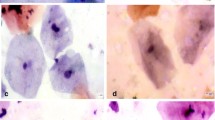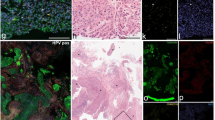Summary
In the present study, the distribution pattern and characteristics of cells containing Factor XIII subunita (FXIII A) have been studied in benign and malignant lesions of human buccal mucosa. Tissues from four irritation fibromas and three squamous cell carcinomas were studied by means of double immunofluorescent staining techniques in which the detection of FXIII A was combined with a reaction with CD14 (recognizing a monocyte/macrophage differentiation marker antigen), Mac 387 (reacting with a special subset of macrophages), anti-HLA-DR, Ki-M7 (labelling phagocytosing macrophages) or Ki-67 (visualizing a nuclear antigen associated with cell proliferation) monoclonal antibodies. FXIII A was detected in cells of the connective tissue stroma in both benign and malignant buccal lesions. The number of these FXIII A-reactive cells (FXIII A+ cells) increased considerably in the tumour tissues, in particular in those surrounding tumour cell clusters. FXIII A+ cells scattered in the fibromatous tissues were spindle-shaped, whereas in the tumour stroma, large stellate cells predominated, and round cells were likewise labelled around blood vessels. FXIII A+ cells were labelled with CD14 and Ki-M7 in both fibromatous and tumoural buccal mucosa; however, they failed to show any reaction with Ki-67. FXIII A+ cells accumulated in the tumour stroma reacted for HLA-DR as well. These results indicate that in both the benign and malignant buccal lesions FXIII A is contained in a subpopulation of tissue macrophages, which represents a monocyte-derived (CD14+) and phagocytosing (KiM7+) cell population. The accumulation of the FXIII A+ cells in the tumour stroma is believed to be a result of direct migration from the circulating blood. The FXIII A+ cells of the tumour stroma may be actively involved in both antigen presentation and matrix remodelling during tumour progression.
Similar content being viewed by others
References
Ádány,R. (1993) Janus-faced tumour associated macrophages.Immunol. Today 14, 142–3.
Ádány,R.,Kappelmayer,J. &Muszbek,L. (1987a) Expression of factor XIII subunita in different types of macrophages.Adv. Biosci. 66, 323–33.
Ádány,R.,Kiss,A. &Muszbek,L. (1987b) Factor XIII: a marker of mono- and megakariocytopoesis.Br. J. Haematol. 67, 167–72.
Ádány,R.,Glukhova,A. M.,Kabakov,A. Y. &Muszbek,L. (1988a) Characterization of human connective tissue cells containing factor XIII subunita.J. Clin. Pathol. 41, 49–56.
Ádány,R.,Szegedi,A.,Ablin,R. J. &Muszbek,L. (1988b) Fibrinolysis resistant fibrin deposits in lymph nodes with Hodgkin's disease.Thromb. Haemostas. 60, 293–7.
Ádány,R.,Fodor,F.,Molnar,P.,Ablin,R. J. &Muszbek,L. (1990) Increased density of histiocytes in uterine leiomyomas.Int. J. Gynec. Pathol. 9, 137–44.
Barry,E. L. &Mosher,D. F. (1988) Factor XIII cross-linking of fibronectin at cellular matrix assembly sites.J. Biol. Chem. 263, 10464–9.
Barry,E. L. &Mosher,D. F. (1989) Factor XIIIa-mediated cross-linking of fibronectin in fibroblast cell layers. Cross-linking of cellular and plasma fibronectin and of amino-terminal fibronectin fragments.J. Biol. Chem. 264, 4179–85.
Brandtzaeg,P.,Dale,I. &Gabrielsen,T. O. (1992) The leucocyte protein L1 (calprotectin): usefulness as an immunohistochemical marker antigen and putative biological function.Histopathology 21, 191–6.
Bruhn,H. D. (1981) Growth regulation of vessel wall cells and of tumour cells by thrombin, factor XIII and fibronectin.Thromb. Haemostas. 46, 762.
Bruhn,H. D. &Pohl,J. (1981) Growth regulation of fibroblasts by thrombin, factor XIII and fibronectin.Klin. Wochenschr. 59, 141–6.
Cerio,R.,Spaull,J. &Jones,E. W. (1989) Histiocytoma cutis: a tumour of dermal dendrocytes (dermal dendrocytoma).Br. J. Dermatol. 120, 197–206.
Evans,R. (1982) Macrophages and neoplasms: new insights and their implication in tumour immunobiology.Cancer Metast. Rev. 1, 227–55.
Fear,J. D.,Jackson,P.,Gray,C.,Miloszewski,K. J. A. &Losowsky,M. S. (1984) Localisation of factor XIII in human tissues using an immunoperoxidase technique.J. Clin. Pathol. 37, 560–3.
Henriksson,P.,Becker,S.,Lynch,G. &Mcdonagh,J. (1985) Identification of intracellular Factor XIII in human monocytes and macrophages.J. Clin. Invest. 76, 528–34.
Heppner,G. H. &Fulton,A. M. (1988)Macrophages and Cancer. Boca Raton: CRC Press.
Keski-Oja,J.,Mosher,D. F. &Vaheri,A. (1976) Cross-linking of a major fibroblast-associated glycoprotein (fibronectin) catalyzed by blood coagulation factor XIII.Cell 9, 29–35.
Kiesselbach,T. H. &Wagner,R. H. (1972) Demonstration of factor XIII in human megakaryocytes by a fluorescent antibody technique.Ann. N. Y. Acad. Sci. 202, 318–28.
Kradin,R. L.,Ynch,G. W.,Kurnick,J. T.,Erikson,M.,Colvin,R. B. &Mcdonagh,J. (1987) Factor XIIIa is synthesized and expressed on the surface of U937 cells and alveolar macrophages.Blood 69, 778–85.
Martinez-Hernandez,A. (1988) The extracellular matrix and neoplasia.Lab. Invest. 58, 609–12.
Mosher,D. F. (1976) Cross-linking of cold insoluble globulin by fibrin-stabilizing factor.J. Biol. Chem. 250, 6614–21.
Mosher,D. F. (1984) Cross-linking of fibronectin to collagenous proteins.Mol. Cell Biochem. 53, 63–8.
Mosher,D. F.,Schad,P. E. &Kleinman,H. K. (1979) Cross-linking of fibronectin to collagen by blood coagulation factor XIIIa.J. Clin. Invest. 64, 781–7.
Muszbek,L. &Ádány,R. (1988) Intratumoural fibrin stabilization. InEicosanoids, Lipid Peroxidation and Cancer (edited byNigram,S.), pp. 339–49. Heidelberg: Springer-Verlag.
Muszbek,L. &Laki,K. (1984) Interaction of thrombin with proteins other than fibrinogen (thrombin-susceptible bonds). Activation of factor XIII. InThe Thrombin (edited byMachovich,R.), pp. 83–102. Boca Raton: CRC Press.
Muszbek,L.,Ádány,R.,Szegedi,G.,Polgár,J. &Kávai,M. (1985) Factor XIII of blood coagulation in human monocytes.Thrombos. Res. 37, 401–10.
Nagy,J. A.,Brown,L. F.,Senger,D. r.,Lanir,N.,Van DeWater,L.,Dvorak,A. M. &Dvorak,H. F. (1988) Pathogenesis of tumour stroma generation: a critical role for leaky blood vessels and fibrin deposits.Biochem. Biophys. Acta 948, 305–26.
Nemeth,A. J. &Penneys,N. S. (1989) Factor XIIIa is expressed by fibroblasts in fibrovascular tumours.J. Cutan. Pathol. 16, 266–71.
Nickoloff,B. J. &Griffiths,C. E. (1989) Factor XIIIa-expressing dermal dendrocytes in AIDS-associated cutaneous Kaposi's sarcomas.Science 243, 1736–7.
Paye,M.,Nusgens,B. V. &Lapiere,C. M. (1989) Factor XIII of blood coagulation modulates collagen biosynthesis by fibroblastsin vitro.Haemostasis 19, 274–83.
Paye,M.,Read,D.,Nusgens,B.,Lapiere,C. M. (1990) Factor XIII in scleroderma:in vitro studies.Br. J. Dermatol. 122, 371–82.
Toida,M.,Okumura,Y.,Handa,Y.,Watanabe,F.,Tatematsu,N.,Oka,N.,Takami,T. &Ojima,A. (1990a) Factor XIIIa-positive cells in the human pulmonary tissues: an immunohistochemical study.Acta Histochem. Cytochem. 23, 671–8.
Toida,M.,Tsai,C. S.,Okumura,Y.,Tatematsu,N. &Oka,N. (1990b) Distribution of Factor XIIIa-containing cells and collagenous components in radicular cysts: histochemical and immunohistochemical studies.J. Oral Pathol. Med. 19, 155–9.
Toida,M.,Okumura,Y. &Takami,T. (1991) Cells containing factor XIIIa and pulmonary fibrosis induced by bleomycin.J. Clin. Pathol. 44, 255–6.
Toida,M.,Ka,N.,Takami,T. &Ádány,R. (1995) Accumulation of cells containing Factor XIII subunita around the foci of intense fibrosis in human epulides.Histochem. J. 27, 440–8.
Ueyama,M. &Urayama,T. (1977) The role of factor XIII in fibroblast proliferation.Jpn. J. Exp. Med. 48, 135–42.
Weisberg,L. J.,Shiu,D. T.,Conkling,P. R. &Shuman,M. A. (1987) Identification of normal human peripheral blood monocytes and liver as sites of synthesis of coagulation factor XIIIa-chain.Blood 70, 579–82.
Author information
Authors and Affiliations
Rights and permissions
About this article
Cite this article
Toida, M., Okumura, Y., Win, K.K.S. et al. Characterization of cells containing factor XIII subunita in benign and malignant buccal lesions. Histochem J 27, 449–456 (1995). https://doi.org/10.1007/BF02388801
Received:
Revised:
Issue Date:
DOI: https://doi.org/10.1007/BF02388801




